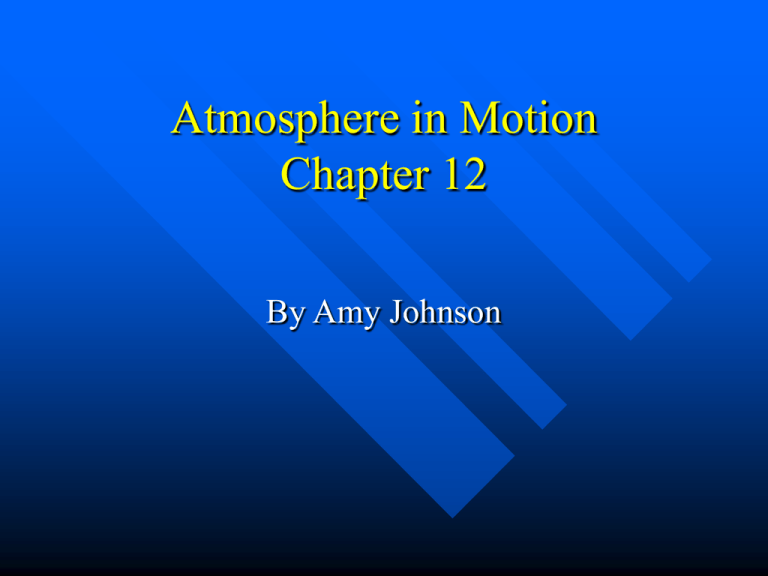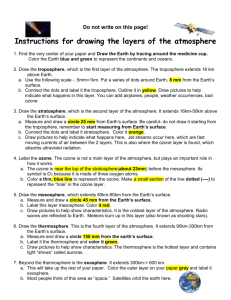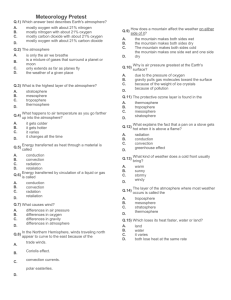Atmosphere in Motion Chapter 12
advertisement

Atmosphere in Motion Chapter 12 By Amy Johnson Atmosphere gases surrounding the Earth – necessary for supporting life – protects against harmful UV and X-ray radiation – absorbs and distributes warmth Galileo Galilei proved air must have weight and contain matter – Weighed flask, injected air, and reweighed to find flask with injected air weighed more Air stores and releases heat, holds moisture, and can exert pressure Composition of Atmosphere subject to the pull of gravity – exerts pressure in all directions, therefore cannot be felt – weight is equal to water over 10 m deep mixture of gases, liquid water, and microscopic particles of solids and other liquids Gases of the Atmosphere Nitrogen – most abundant (78%) Oxygen – necessary for human life (21%) Variety of other gases in trace amounts – water vapor is critical to weather (up to 4%) » Responsible for clouds and precipitation – carbon dioxide allows plants to make food (.03%) » Absorbs heat and emits it back to warm Earth Aerosols in the Atmosphere solids, such as dust, salt, and pollens and tiny droplets of acid – dust comes from volcanoes and wind blowing across the soil – salt results from wind blowing over the ocean – pollen is released by plants – burning coal in power plants also creates aerosols Layers of the Atmosphere based on temperature changes that occur with altitude Lower Layers – Troposphere – Stratosphere Upper Layers – Mesosphere » Ionosphere – Thermosphere – Exosphere Troposphere closest to the Earth (about 10 km) contains about ¾ of Earth’s entire atmosphere including clouds and weather about 50% of Sun’s energy passes through Earth’s surface heats by conduction – the farther from the surface you get, the cooler it becomes Stratosphere above troposphere (10 km – 50 km) contains most of the ozone – Absorbs ultraviolet radiation to warm area » As you go up, you get warmer – without ozone, the UV radiation would reach Earth and cause health problems Mesosphere Extends 50km – 85km above surface Contains very little ozone so temperature drops to the lowest in atmosphere Ionosphere part of mesosphere and thermosphere due to intense interaction with the sun’s radiation reflects AM radio waves allowing longdistance communications possible – static results when interaction between this layer and radiation is too active Thermosphere reaches 85km – 500km temperatures increase rapidly filters out harmful X-rays and gamma rays from the Sun Exosphere outermost layer extends outward to where space begins – no clear boundary to space GREENHOUSE EFFECT Earth’s Water 70% of Earth’s surface is water Stored throughout the land-oceanatmosphere system in three different states – Solid – snow, ice, glaciers – Liquid – oceans, lakes, rivers – Gas – water vapor Water Cycle



![Earth's Atmosphere Earths Atmosphere [Autosaved]](http://s2.studylib.net/store/data/010123574_1-f1783c71f4d74c47566894d317b29466-300x300.png)







